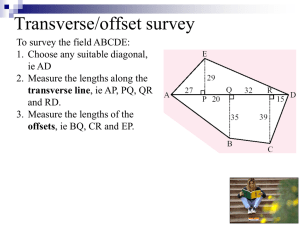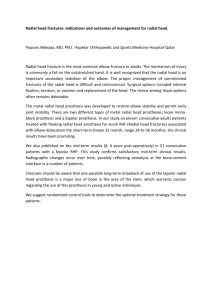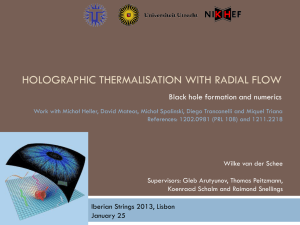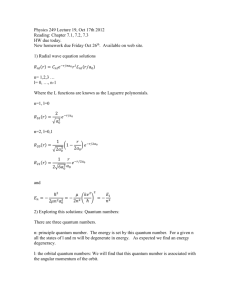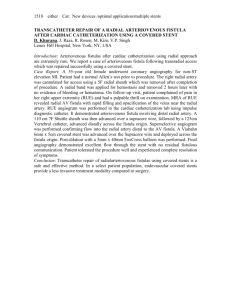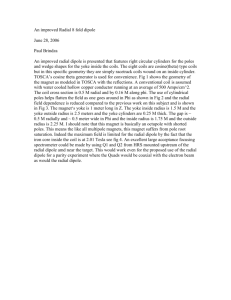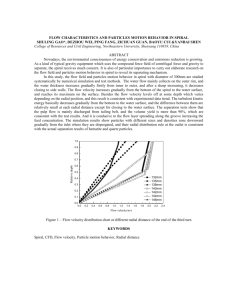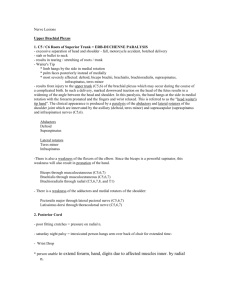RADIAL GLIAL CELLS. key organisers in CNS development
advertisement
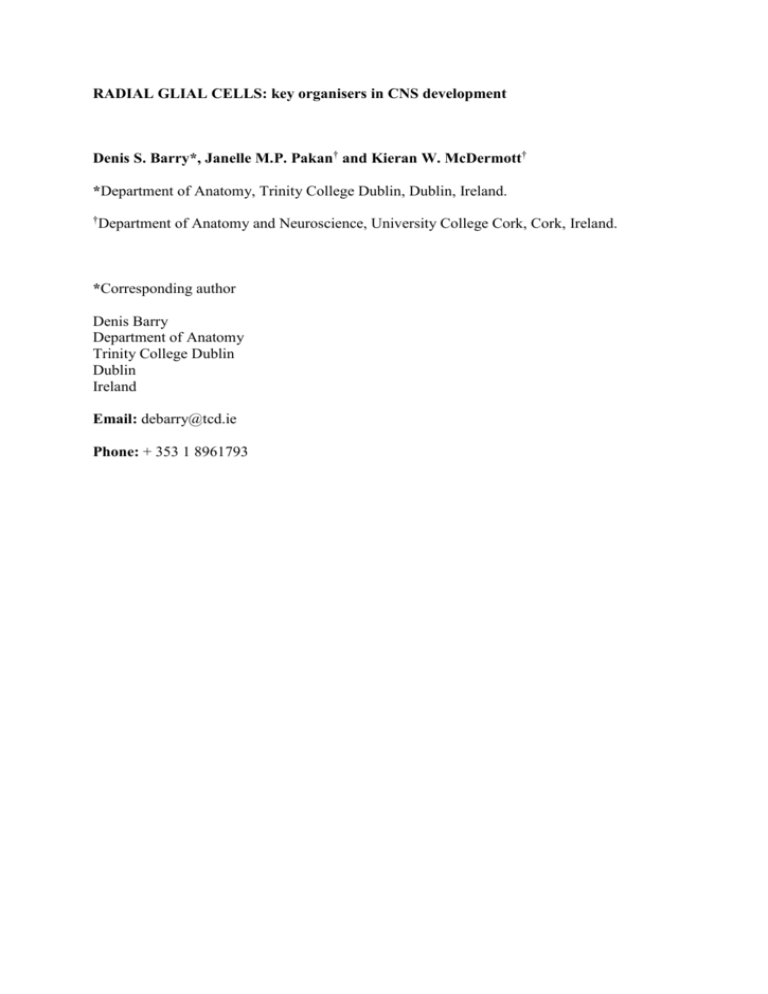
RADIAL GLIAL CELLS: key organisers in CNS development Denis S. Barry*, Janelle M.P. Pakan† and Kieran W. McDermott† *Department of Anatomy, Trinity College Dublin, Dublin, Ireland. † Department of Anatomy and Neuroscience, University College Cork, Cork, Ireland. *Corresponding author Denis Barry Department of Anatomy Trinity College Dublin Dublin Ireland Email: debarry@tcd.ie Phone: + 353 1 8961793 Abstract Radial glia are elongated bipolar cells present in the CNS during development. Our understanding of the unique roles these cells play has significantly expanded in the last decade. Historically, radial glial cells were primarily thought to provide an architectural framework for neuronal migration. Recent research reveals that radial glia play a more dynamic and integrated role in the development of the brain and spinal cord. They represent a major progenitor pool during early development and can give rise to a small population of multipotent cells in neurogenic niches of the adult CNS. Radial glial cells are a heterogeneous population, with divergent and often poorly understood roles across different brain and spinal cord regions during development; this heterogeneity extends to specialized adult subtypes, such as tanycytes, Müller glial cells and Bergman glial cells which possess morphological similarities to radial glial but play distinct functional roles in the CNS. Keywords: Radial glia, neurodevelopment, neuronal migration, glioma Cell Facts Radial glial cells differentiate from neuroepithelial cells in the developing CNS. Radial glial cells possess an elongated radial process spanning the CNS from the ventricular zone to the pial surface. Radial glial cells have multifunctional roles; they provide structural support during axon growth, they act as a scaffold for neuronal migration. Radial glial cells are important progenitor cells contributing to gliogenesis in all regions and additionally to neurogenesis in the mammalian cerebral cortex. Radial glial cells are a transient cell type present mainly during development although a few exceptional radial glial-like cell populations exist into adulthood. Alterations in the radial glial cell network during development may lead to disorganized CNS tissues resulting in different neurodevelopmental disorders. Introduction Radial glial cells have been the subject of much interest during the on-going efforts to understand CNS formation. This cell type, with its long radial process, was originally discovered spanning the foetal spinal cord by Camillo Golgi in 1885 (Rakic, 2003). Ramon Cajal originally suggested a glial identity for these cells by demonstrating their morphological similarities with astrocytes, but their glial phenotype was ultimately confirmed 60 years later when immunohistochemistry and electron microscopy showed that radial glial cells contain glycogen granules and GFAP, which are intracellular characteristics found only in glia (Choi, 1981; Levitt & Rakic, 1980). Today, radial glial cells are recognised as morphologically, biochemically and functionally distinct from other neural cell types. They display an apical - basal polarity possessing a periventricular cell body and an elongated process extending from a ventricular attachment to an end-foot anchored to the opposing pial surface (Fig. 1A, B). Some radial glia are thought to persist into adult life, albeit in very limited numbers, and some in specific neurogenic niches. Radial glia subtypes have also been identified, including tanycytes around the ventricles, Müller glia in the retina and Bergmann glia in the cerebellum (Fig. 1C-E). Notably, both Müller and Bergmann glia preserve their radial morphology postnatally (Guo et al, 2013; Surzenko et al, 2013). The classical role of radial glia is in neuronal migration (Rakic, 1972), acting as guidance cables aiding the migration of new-born neurons; however, modern cell fate determination and imaging methodologies have revealed that radial glia are also multifunctional neural stem cells that structurally orchestrate CNS organization and generate different cells types, conforming to the needs of the different neural compartments they occupy. Cell origin and plasticity Neuroepithelial cells arise from the ectoderm early in development, divide symmetrically and generate the neural plate. This invaginates to form the neural tube, the width of which is occupied by a polarised pseudostratified neuroepithelium. Neuroepithelial cells possess a basal side attached to the pial surface and an apical side that contacts the lumen of the neural tube. As development proceeds, they multiply and form the CNS germinal zones, namely the ventricle zone and subventricular zones. Here, neuroepithelial cells, most of which by now have a radial morphology and are termed radial neuroepithelial cells, serve as neural stem cells, expanding the CNS by self-renewing and populating it by generating neurons and glia. After completing the early phases of neurogenesis, they begin their transformation into radial glial cells. This is initiated by the down regulation of epithelial features, such as tight junctions (Aaku-Saraste et al, 1996) and completed by the up regulation of glial specific identifiers such as the membrane proteins GLAST and BLBP (Morest & Silver, 2003) and the appearance of cytoplasmic glycogen granules (Gadisseux & Evrard, 1985). Radial glial cells and radial neuroepithelial cells express the intermediate filament nestin (Hartfuss et al, 2001) and both undergo interkinetic neuronal migration (LaMonica et al, 2013; Tsai et al, 2010). While this developmental sequence of events appears to be consistent for many CNS radial glia, in the cerebral cortex they retain the capacity to generate large numbers of neurons. In regions other than the cerebral cortex, the contribution of differentiated radial glia to on-going neurogenesis is unclear. In the spinal cord and cerebellum, their appearance temporally precedes the first appearance of astrocytes and oligodendrocytes suggesting that here most radial glia bypass neurogenesis, and adopt a glial fate after fulfilling their guidance (Rakic, 2003) and boundary forming functions (Barry et al, 2013). Cell functions Radial glia and their subtypes show extraordinary adaptability facilitating the formation of the cerebellum, hypothalamus, cerebral cortex, and spinal cord. While their roles in different CNS regions can overlap, their functions seem to depend on the developmental status of the brain region they occupy. Their longest established and best characterised function is in neuronal migration, intricately guiding new-born neurons from germinal zones to their target destinations in the correct lamina of the cerebral cortex (Fig. 2A, B) (Rakic, 1972; Xu et al, 2013). It is not clear whether or not radial glia support neuronal migration in the developing spinal cord, but it seems unlikely as neurogenesis and neuronal migration largely precede the differentiation of radial glia from the neuroepithelium (Barry & McDermott, 2005). Radial glia are now considered key progenitor cells, comprising the majority of mitotically active cells in brain ventricular zones (Lui et al, 2011; Malatesta & Gotz, 2013; Pilz et al, 2013). Subsequently, many clearly differentiate into astrocytes later in development (Noctor et al, 2004). Moreover, recent in vivo genetic fate mapping experiments have revealed that some radial glia in the cerebral cortex are lineage restricted to generating upper layer neurons, implicating them in human brain evolution (Franco et al, 2012). These stem cell roles for radial glia have transformed the heretofore prevailing view of separate neuroepithelial lineages for neurons and glia. However, as much of this evidence has been obtained using different experimental techniques, in different regions and across different species, it seems premature to assume that all radial glia generate neurons in all regions of the CNS. Apart from their stem cell and neuronal migration roles, radial glia cells also facilitate the formation and compartmentalisation of the white matter (Steindler, 1993). For example, axons forming the corpus callosum grow within a transient glial ‘sling’, which is most likely composed of radial glia, that disappears around the perinatal period (Silver et al, 1982). In the spinal cord, finely organised radial glial processes also create boundaries which separate nascent axon tracts in the emerging dorsal and lateral white matter (Fig. 2C, D) (Barry et al, 2013). These recent observations demonstrate new temporally separated roles for spinal cord radial glia; firstly, organising axonogenesis and then, when axon tracts have matured, generating glial cells. Recent data have also implicated radial glia in the regulation of cerebral cortical vascularisation via modulation of canonical Wnt signalling (Ma et al, 2013). Indeed, inhibition of radial glial cell division in developing cerebral cortex of Orc3 knockout mice leads to neonatal cerebral haemorrhage resulting in major reductions in vessel density and branch point frequency (Ma et al, 2013). This implicates radial glia in the pathogenesis of new-born cerebrovascular diseases, such as perinatal haemorrhagic stroke. Associated Pathologies As described, radial glia give rise to nearly all cortical neurons and glia and serve as neuronal migration conduits. Therefore, dysfunction of radial glial cell cycle has catastrophic consequences for brain lamination. Lissencephaly and micro-lissencephaly (smooth brain) are neurodevelopmental diseases caused by defects in neurogenesis and neural migration and result in reduced brain volume and a lack of cortical sulci and gyri at birth. Affected patients may experience mental retardation, motor and speech dysfunction, balance problems, and epilepsy. More extreme cases result in death within a few months of life (Wu & Wang, 2012). Microlissencephaly and lissencephaly are associated with the radial glial intracellular scaffold protein’s Lis1 and its binding partner Nde1 (Alkuraya et al, 2011; Reiner et al, 1993), which aid in microtubule organisation and play an essential role in radial glial differentiation (Pawlisz & Feng, 2011). Animal models lacking Lis1 and Nde1 show severe neurogenesis and neuronal migration abnormalities (Pawlisz & Feng, 2011). Further insight into the precise mechanisms underlying how radial glia mediate neuronal migration are essential when considering the pathologies resulting from lissencephaly and other developmental disorders that cause abnormal migration, such as foetal alcohol syndrome. Gliomas are the most common adult brain tumours and often the most lethal. Some are thought to originate during development (Vick et al, 1977) and oncogenic cells have been linked to progenitor cell populations resident not only during development, but also in the adult (Sanai et al, 2005; Wu & Wang, 2012). It is not unsurprising, therefore, that radial glia are recognised as potential targets of oncogenic inducers and have high potential for malignant transformation (De Rosa et al, 2012; Wu & Wang, 2012). A full understanding of the lifecycle of a neural stem cell will be central to our understanding of embryonic brain tumorigenesis and related developmental diseases. Acknowledgements The authors wish to acknowledge funding from the following sources: The Health Research Board of Ireland, Programme for Research in Third Level Institutions, The Irish Research Council. Figure Legends Figure 1. Radial glial cells and radial glial-like subtypes in the embryonic and adult CNS. A) Radial glial cell bodies are present in the ventricular zone (VZ) of the developing spinal cord. Their processes extend from the central canal (CC) through developing white matter (WM) to the pial surface. B) Radial glia in the developing cerebral cortex also have cell bodies in the VZ and their processes extend though the sub-ventricular zone (SVZ) and the developing cortical plate (CP) to the pial surface. C) Tanycytes in the adult hypothalamus have cell bodies adjacent to the third ventricle (3V) and processes that extend to the pial surface. D) In the adult cerebellar cortex Bergmann glia have cell bodies in the Purkinje cell layer (PCL) and extend highly branched processes through the molecular layer (ML) to the pial surface. E) Müller glia in the adult retina are large elongated cells extending from the photoreceptors (PR) to the ganglion cell layer (GCL). Median eminence (ME), arcuate nucleus (AN), ventromedial hypothalamus (VMH), granule cell layer (GL), inner and outer nuclear layer (INL and ONL), inner and outer plexiform layer (IPL and OPL). Figure 2. Radial glial cell structure and function in the developing CNS. A) Progenitor cell potential of neuroepithelial cells and radial glia during development. Neuroepithelial cells proliferate and generate neuroblasts and immature neurons. They then differentiate into radial glia which proliferate and elongate. Radial glia in the cortex contribute to neurogenesis directly or via immediate neuronal precursor cells (nIPC). Cortical and spinal cord radial glia contribute to gliogenesis by producing astrocytes (light blue) and possibly oligodendrocytes. Some radial glia may also differentiate into ependymal cells which line the ventricles of the adult CNS. B) Radial glia proliferate at the apical surface of the VZ and serve as scaffolds for newly formed neurons to migrate through the SVZ and into the developing CP. This process may also facilitate the migration of radial glial cell derived astrocytes. C) BLBP-expressing radial glial processes form structural boundaries in the spinal cord, delineating the putative dorsal columns cord (inset). D) A 3-dimensional cross-section view of the embryonic spinal cord (see red inset schematic) showing BLBP-expressing radial glia forming distinct corridors (arrows) in the white matter, through which axons may grow. Scale bars = 50 µm. References Aaku-Saraste E, Hellwig A, Huttner WB (1996) Loss of occludin and functional tight junctions, but not ZO-1, during neural tube closure--remodeling of the neuroepithelium prior to neurogenesis. Developmental biology 180: 664-679 Alkuraya FS, Cai X, Emery C, Mochida GH, Al-Dosari MS, Felie JM, Hill RS, Barry BJ, Partlow JN, Gascon GG, Kentab A, Jan M, Shaheen R, Feng Y, Walsh CA (2011) Human mutations in NDE1 cause extreme microcephaly with lissencephaly [corrected]. American journal of human genetics 88: 536-547 Barry D, McDermott K (2005) Differentiation of radial glia from radial precursor cells and transformation into astrocytes in the developing rat spinal cord. Glia 50: 187-197 Barry DS, Pakan JM, O'Keeffe GW, McDermott KW (2013) The spatial and temporal arrangement of the radial glial scaffold suggests a role in axon tract formation in the developing spinal cord. Journal of anatomy 222: 203-213 Choi BH (1981) Radial glia of developing human fetal spinal cord: Golgi, immunohistochemical and electron microscopic study. Brain research 227: 249-267 De Rosa A, Pellegatta S, Rossi M, Tunici P, Magnoni L, Speranza MC, Malusa F, Miragliotta V, Mori E, Finocchiaro G, Bakker A (2012) A radial glia gene marker, fatty acid binding protein 7 (FABP7), is involved in proliferation and invasion of glioblastoma cells. PloS one 7: e52113 Franco SJ, Gil-Sanz C, Martinez-Garay I, Espinosa A, Harkins-Perry SR, Ramos C, Muller U (2012) Fate-restricted neural progenitors in the mammalian cerebral cortex. Science 337: 746-749 Gadisseux JF, Evrard P (1985) Glial-neuronal relationship in the developing central nervous system. A histochemical-electron microscope study of radial glial cell particulate glycogen in normal and reeler mice and the human fetus. Developmental neuroscience 7: 12-32 Guo Z, Wang X, Xiao J, Wang Y, Lu H, Teng J, Wang W (2013) Early postnatal GFAPexpressing cells produce multilineage progeny in cerebrum and astrocytes in cerebellum of adult mice. Brain research 1532: 14-20 Hartfuss E, Galli R, Heins N, Gotz M (2001) Characterization of CNS precursor subtypes and radial glia. Developmental biology 229: 15-30 LaMonica BE, Lui JH, Hansen DV, Kriegstein AR (2013) Mitotic spindle orientation predicts outer radial glial cell generation in human neocortex. Nature communications 4: 1665 Levitt P, Rakic P (1980) Immunoperoxidase localization of glial fibrillary acidic protein in radial glial cells and astrocytes of the developing rhesus monkey brain. The Journal of comparative neurology 193: 815-840 Lui JH, Hansen DV, Kriegstein AR (2011) Development and evolution of the human neocortex. Cell 146: 18-36 Ma S, Kwon HJ, Johng H, Zang K, Huang Z (2013) Radial glial neural progenitors regulate nascent brain vascular network stabilization via inhibition of Wnt signaling. PLoS biology 11: e1001469 Malatesta P, Gotz M (2013) Radial glia - from boring cables to stem cell stars. Development 140: 483-486 Morest DK, Silver J (2003) Precursors of neurons, neuroglia, and ependymal cells in the CNS: what are they? Where are they from? How do they get where they are going? Glia 43: 6-18 Noctor SC, Martinez-Cerdeno V, Ivic L, Kriegstein AR (2004) Cortical neurons arise in symmetric and asymmetric division zones and migrate through specific phases. Nature neuroscience 7: 136-144 Pawlisz AS, Feng Y (2011) Three-dimensional regulation of radial glial functions by Lis1Nde1 and dystrophin glycoprotein complexes. PLoS biology 9: e1001172 Pilz GA, Shitamukai A, Reillo I, Pacary E, Schwausch J, Stahl R, Ninkovic J, Snippert HJ, Clevers H, Godinho L, Guillemot F, Borrell V, Matsuzaki F, Gotz M (2013) Amplification of progenitors in the mammalian telencephalon includes a new radial glial cell type. Nature communications 4: 2125 Rakic P (1972) Mode of cell migration to the superficial layers of fetal monkey neocortex. The Journal of comparative neurology 145: 61-83 Rakic P (2003) Developmental and evolutionary adaptations of cortical radial glia. Cerebral cortex 13: 541-549 Reiner O, Carrozzo R, Shen Y, Wehnert M, Faustinella F, Dobyns WB, Caskey CT, Ledbetter DH (1993) Isolation of a Miller-Dieker lissencephaly gene containing G protein beta-subunit-like repeats. Nature 364: 717-721 Sanai N, Alvarez-Buylla A, Berger MS (2005) Neural stem cells and the origin of gliomas. The New England journal of medicine 353: 811-822 Silver J, Lorenz SE, Wahlsten D, Coughlin J (1982) Axonal guidance during development of the great cerebral commissures: descriptive and experimental studies, in vivo, on the role of preformed glial pathways. The Journal of comparative neurology 210: 10-29 Steindler DA (1993) Glial boundaries in the developing nervous system. Annual review of neuroscience 16: 445-470 Surzenko N, Crowl T, Bachleda A, Langer L, Pevny L (2013) SOX2 maintains the quiescent progenitor cell state of postnatal retinal Muller glia. Development 140: 1445-1456 Tsai JW, Lian WN, Kemal S, Kriegstein AR, Vallee RB (2010) Kinesin 3 and cytoplasmic dynein mediate interkinetic nuclear migration in neural stem cells. Nature neuroscience 13: 1463-1471 Vick NA, Lin MJ, Bigner DD (1977) The role of the subependymal plate in glial tumorigenesis. Acta neuropathologica 40: 63-71 Wu Q, Wang X (2012) Neuronal stem cells in the central nervous system and in human diseases. Protein & cell 3: 262-270 Xu H, Yang Y, Tang X, Zhao M, Liang F, Xu P, Hou B, Xing Y, Bao X, Fan X (2013) Bergmann glia function in granule cell migration during cerebellum development. Molecular neurobiology 47: 833-844
